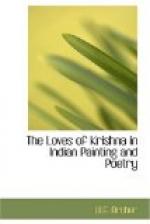The incident is unrecorded in the Bhagavata Purana but appears in later poetry as an instance of Radha and Krishna’s mutual fun—teasing being an essential part of their love-making.
The picture is by the same master artist as Plate 19.
[Illustration]
PLATE 36
Krishna meeting Radha
Illustration to a poem from the Sat Sai of
Bihari
Kangra, Punjab Hills, c. 1790
N.C. Mehta collection. Bombay
An example of Krishna’s meetings with Radha. Appearing as if by accident Krishna is lolling on his cowherd’s stick while Radha, encouraged by a friend, has come to meet him. As she stands, there ensues that idyllic ‘meeting of eyes’ which Indian sentiment regarded as one of the most electrifying experiences in romance. In the picture, a tree pushes its flowering branches across open rolling slopes, suggesting by its fresh upsurgence the exquisite emotions stirring in Radha’s and Krishna’s hearts.
The picture is most probably by the Kangra artist, Kushala, to whom Plate 21 may also be assigned.
[Illustration]
PLATE 37
Radha’s Longing
Guler, Punjab Hills, c. 1810
Bharat Kala Bhawan, Banaras
In Indian painting and poetry, it was women driven to distraction by unappeased longing rather than men hungry with desire who formed the chief subject of romantic art. Pictures focussed on woman in all her varied moods and flattered the male mind by portraying her wilting with sadness when deprived of husband or lover.
The present picture shows Radha frenziedly contemplating her lonely state. Ornaments grown too hot for wearing—from the passion burning in her heart—are strewn about the bed, while hands tightly clasped suggest her wild unhappy torment. The vast and barren hills, empty angular buildings, tiny guttering candles and lonely flowering tree provide a sympathetic setting.
With its sinuous line and innocent delight in feminine form, the picture is typical of Guler painting at the start of the nineteenth century.
[Illustration]
PLATE 38
Radha and Krishna returning in the Rain
Nahan, Punjab Hills, c. 1820
State Museum, Lahore.
A scene from Radha and Krishna’s idyllic life together. Caught by a gale of wind and rain, the lovers are hurrying to shelter, Krishna carrying a leaf umbrella while cows and cowherds bend before the storm. In the distance, small figures wearing hooded cloaks hasten towards the village. Although keenly evocative of actual landscapes in the Punjab Hills—where palaces were usually set on rocky hill-tops with nearby villages clustering at their feet—the picture’s main concern is to illustrate and interpret the lovers’ feelings. The black clouds lit by eerie lightning and the trees tossing and swaying in the wind symbolize the passion raging in their hearts and suggest its ultimate outcome.




